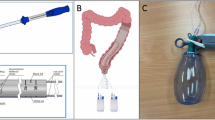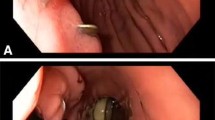Abstract
Background
Defunctioning ostomy is commonly used to protect patients from anastomotic leakage complications after low anterior resection, but is fraught with its own deleterious effects. This first-in-human study examines the safety and preliminary efficacy of Colovac, an anastomosis protection device. The Colovac consists of a flexible bypass sheath, placed in the lumen of colon and anchored above the anastomosis using a vacuum stent.
Methods
15 patients underwent anterior resection (AR) with anastomosis protection by Colovac at 3 European centers. After 14 days, the anastomosis integrity was examined by CT scan and endoscopy. The device was then endoscopically removed. Data regarding demographics, surgical details, 30 day post-operative complications, and patient satisfaction were collected prospectively.
Results
15 patients (10 male) underwent laparoscopic AR with Colovac placement. Preoperative neoadjuvant therapy was administered to 54% of patients. Device placement was uneventful in all patients with a median duration of 7 min and placement was judged as easy or very easy in 93% of the cases. Patients did not report major discomfort during the 14 days. Endoscopic removal (10 min) was judged as easy or very easy in 87% of the cases. Absence of feces below the Colovac anchoring site was observed in 100% of the cases. 4 anastomotic leakages were observed (including 3 device migrations). Overall 5 patients (33%) required a planned stoma creation. At 3 months, 1 had already been closed.
Conclusion
Colovac provides a minimally invasive protection of the anastomosis during the healing process by avoiding the need for a diverting ostomy for two-thirds of patients who will not experience anastomotic complications and allowing safe conversion to the standard of care for patients requiring extended anastomotic protection. A larger study is ongoing to confirm these results.


Similar content being viewed by others
References
Bray F, Ferlay J, Soerjomataram I, Siegel RL, Torre LA, Jemal A (2018) Global cancer statistics 2018: gLOBOCAN estimates of incidence and mortality worldwide for 36 cancers in 185 countries. CA Cancer J Clin 68:394–424
Denost Q, Rouanet P, Faucheron JL, Panis Y, Meunier B, Cotte E, Meurette G, Kirzin S, Sabbagh C, Loriau J, Benoist S, Mariette C, Sielezneff I, Lelong B, Mauvais F, Romain B, Barussaud ML, Germain C, Picat MQ, Rullier E, Laurent C, French Research Group of Rectal Cancer S (2017) To drain or not to drain infraperitoneal anastomosis after rectal excision for cancer: the GRECCAR 5 Randomized Trial. Ann Surg 265:474–480
Lefevre JH, Mineur L, Kotti S, Rullier E, Rouanet P, de Chaisemartin C, Meunier B, Mehrdad J, Cotte E, Desrame J, Karoui M, Benoist S, Kirzin S, Berger A, Panis Y, Piessen G, Saudemont A, Prudhomme M, Peschaud F, Dubois A, Loriau J, Tuech JJ, Meurette G, Lupinacci R, Goasgen N, Parc Y, Simon T, Tiret E (2016) Effect of Interval (7 or 11 weeks) between neoadjuvant radiochemotherapy and surgery on complete pathologic response in rectal cancer: a multicenter, randomized, controlled Trial (GRECCAR-6). J Clin Oncol 34:3773–3780
Celerier B, Denost Q, Van Geluwe B, Pontallier A, Rullier E (2015) The risk of definitive stoma formation at ten years after low and ultra-low anterior resection for rectal cancer. Colorectal Dis 18(1):59–66
Maggiori L, Bretagnol F, Lefevre JH, Ferron M, Vicaut E, Panis Y (2011) Conservative management is associated with a decreased risk of definitive stoma after anastomotic leakage complicating sphincter-saving resection for rectal cancer. Colorectal Dis 13:632–637
Mirnezami A, Mirnezami R, Chandrakumaran K, Sasapu K, Sagar P, Finan P (2011) Increased local recurrence and reduced survival from colorectal cancer following anastomotic leak: systematic review and meta-analysis. Ann Surg 253:890–899
Matthiessen P, Hallbook O, Rutegard J, Simert G, Sjodahl R (2007) Defunctioning stoma reduces symptomatic anastomotic leakage after low anterior resection of the rectum for cancer: a randomized multicenter trial. Ann Surg 246:207–214
Danielsen AK, Park J, Jansen JE, Bock D, Skullman S, Wedin A, Marinez AC, Haglind E, Angenete E, Rosenberg J (2017) Early closure of a temporary ileostomy in patients with rectal cancer: a multicenter randomized controlled trial. Ann Surg 265:284–290
Maggiori L, Moszkowicz D, Zappa M, Mongin C, Panis Y (2015) Bioprosthetic mesh reinforcement during temporary stoma closure decreases the rate of incisional hernia: a blinded, case-matched study in 94 patients with rectal cancer. Surgery 158(6):1651–1657
den Dulk M, Smit M, Peeters KC, Kranenbarg EM, Rutten HJ, Wiggers T, Putter H, van de Velde CJ, Dutch Colorectal Cancer G (2007) A multivariate analysis of limiting factors for stoma reversal in patients with rectal cancer entered into the total mesorectal excision (TME) trial: a retrospective study. Lancet Oncol 8:297–303
Morks AN, Havenga K, Ploeg RJ (2011) Can intraluminal devices prevent or reduce colorectal anastomotic leakage: a review. World J Gastroenterol 17:4461–4469
Egozi L, Sorrento JJ, Golub R, Schultz EH (1993) Complication of the intracolonic bypass. Report of a case. Dis Colon Rectum 36:191–193
Bakker IS, Morks AN, Hoedemaker HO, Burgerhof JG, Leuvenink HG, Ploeg RJ, Havenga K (2012) The C-seal trial: colorectal anastomosis protected by a biodegradable drain fixed to the anastomosis by a circular stapler, a multi-center randomized controlled trial. BMC Surg 12:23
Hays RD, Bjorner JB, Revicki DA, Spritzer KL, Cella D (2009) Development of physical and mental health summary scores from the patient-reported outcomes measurement information system (PROMIS) global items. Qual Life Res 18:873–880
Benoit O, Faron M, Margot N, Creavin B, Debove C, Tiret E, Parc Y, Lefevre JH (2019) C-reactive protein values after colorectal resection: can we discharge a patient with a C-reactive protein value > 100? A retrospective cohort study. Dis Colon Rectum 62:88–96
Waterland P, Ng J, Jones A, Broadley G, Nicol D, Patel H, Pandey S (2016) Using CRP to predict anastomotic leakage after open and laparoscopic colorectal surgery: is there a difference? Int J Colorectal Dis 31:861–868
Phan K, Oh L, Ctercteko G, Pathma-Nathan N, El Khoury T, Azam H, Wright D, Toh JWT (2019) Does a stoma reduce the risk of anastomotic leak and need for re-operation following low anterior resection for rectal cancer: systematic review and meta-analysis of randomized controlled trials. J Gastrointest Oncol 10:179–187
Fernandez Lobato R, Pinto I, Maillo C, Paul L, Fradejas JM, Moreno Azcoita M (1999) Rectovesical fistula treated by covered self-expanding prosthesis: report of a case. Dis Colon Rectum 42:812–815
Jeyarajah AR, Shepherd JH, Fairclough PD, Patchett SE (1997) Effective palliation of a colovaginal fistula using a self-expanding metal stent. Gastrointest Endosc 46:367–369
Paul L, Pinto I, Gomez H, Fernandez-Lobato R, Moyano E (2002) Metallic stents in the treatment of benign diseases of the colon: preliminary experience in 10 cases. Radiology 223:715–722
Matthiessen P, Hallbook O, Andersson M, Rutegard J, Sjodahl R (2004) Risk factors for anastomotic leakage after anterior resection of the rectum. Colorectal Dis 6:462–469
Alves A, Panis Y, Lelong B, Dousset B, Benoist S, Vicaut E (2008) Randomized clinical trial of early versus delayed temporary stoma closure after proctectomy. Br J Surg 95:693–698
Yin TC, Tsai HL, Yang PF, Su WC, Ma CJ, Huang CW, Huang MY, Huang CM, Wang JY (2017) Early closure of defunctioning stoma increases complications related to stoma closure after concurrent chemoradiotherapy and low anterior resection in patients with rectal cancer. World J Surg Oncol 15:80
Nelson T, Pranavi AR, Sureshkumar S, Sreenath GS, Kate V (2018) Early versus conventional stoma closure following bowel surgery: a randomized controlled trial. Saudi J Gastroenterol 24:52–58
Reshef A, Ben-Arie G, Pinsk I (2019) Protection of colorectal anastomosis with an intraluminal bypass device for patients undergoing an elective anterior resection: a pilot study. Tech Coloproctol 23(6):565–571
Law WL, Choi HK, Lee YM, Ho JW, Seto CL (2007) Anastomotic leakage is associated with poor long-term outcome in patients after curative colorectal resection for malignancy. J Gastrointest Surg 11:8–15
Funding
This study has been funded by SafeHeal. SafeHeal is the manufacturer of the Colovac device. This study was presented as an oral communication at the 2019 SAGES Meeting in Baltimore, MD, USA.
Author information
Authors and Affiliations
Corresponding author
Ethics declarations
Disclosures
Prof. J. H. Lefevre is a consultant for SafeHeal. Prof. J. H. Lefevre has received funding from SafeHeal to support congress registration and travel fees. Dr. A. D’Urso and Dr. N. Komen have no conflicts of interest to disclose.
Additional information
Publisher's Note
Springer Nature remains neutral with regard to jurisdictional claims in published maps and institutional affiliations.
Rights and permissions
About this article
Cite this article
D’Urso, A., Komen, N. & Lefevre, J.H. Intraluminal flexible sheath for the protection of low anastomosis after anterior resection: results from a First-In-Human trial on 15 patients. Surg Endosc 34, 5107–5116 (2020). https://doi.org/10.1007/s00464-019-07279-8
Received:
Accepted:
Published:
Issue Date:
DOI: https://doi.org/10.1007/s00464-019-07279-8




